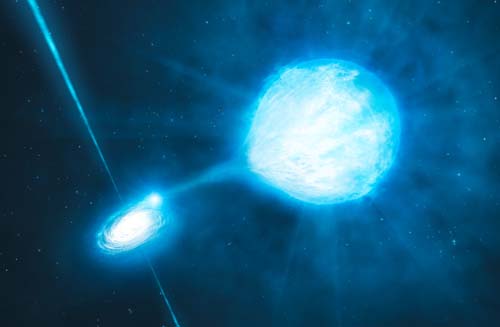Bright Jet Outshines Black Hole in X-ray Light
22.03.2010 —
X-ray binary star systems have been the focus of astronomers for a long time. The unique characteristic of such binary systems, comprising an ordinary star and a black hole (or a neutron star), is that this combination usually leads to a gas flow between both objects. The heated gas gathers as an accretion disk surrounding the black hole; strong magnetic fields then ensure that parts of the gas can be fired into outer space in the form of a highly-energetic and densely bundled stream of matter – a „jet“. These phenomena emit characteristic X-rays, on the basis of which astronomers can identify such systems.
Astronomers have for the first time succeeded in separating out the radiation from the accretion disk and the jet. When it came to an outburst in the X-ray binary XTE J1550-564 in the year 2000, data in the infra-red, optical and X-ray wavebands were recorded with the help of the Rossi X-Ray Timing Explorer. The system is 17,000 light years away from Earth and is located in the constellation of Taurus. During their investigation researchers discovered something very surprising: practically all the X-ray radiation from the system is generated in its jet and not in the accretion disk. This result contradicts findings that were obtained from earlier theoretical models. Robert Dunn, a scientist at the Munich Excellence Cluster Universe, contributed an analysis of the X-ray data of the Rossi X-Ray Timing Explorer to the above work.
 Artist's impression of the Rossi X-Ray Timing Explorer satellite
Artist's impression of the Rossi X-Ray Timing Explorer satellite
// © CXC/M.Weiss
David Russell from the University of Amsterdam and his colleagues observed the development of the source over time. Since the discovery of the first X-ray binary, a lively discussion has been going on among experts as to the precise origin of the emitted X-ray radiation. The researchers point out that, according to their results, the energy emission of the jet is much greater than previously assumed. The work is an important step in the study of X-ray binaries. In the next step, the goal is to examine through which mechanism and where exactly the radiation is generated.
„These findings on the emission processes of jets will play an important role in future studies of black holes“, Robert Dunn explains. „With the new data, scientists can improve on previous theoretical models. We will thus be able to understand more clearly how jets of very large black holes behave and influence the development of galaxies.“
Link to original publication: http://arxiv.org/abs/1002.3729






